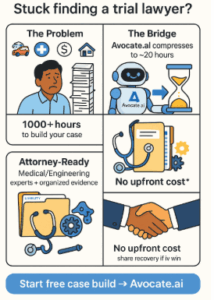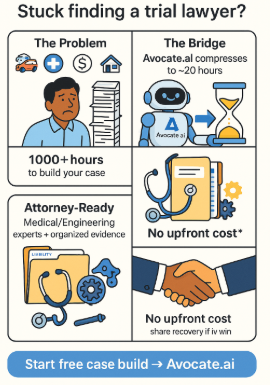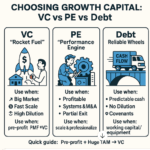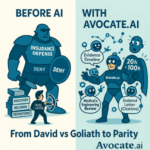 If you’ve been the victim of fraud, a car crash, medical malpractice, a landlord’s deceit, or workplace discrimination, the hardest part often isn’t knowing you were wronged—it’s finding a great trial lawyer willing to take your case. That mismatch frustrates thousands of people every year. Here’s why the system works the way it does—and how Avocate.ai is built to help.
If you’ve been the victim of fraud, a car crash, medical malpractice, a landlord’s deceit, or workplace discrimination, the hardest part often isn’t knowing you were wronged—it’s finding a great trial lawyer willing to take your case. That mismatch frustrates thousands of people every year. Here’s why the system works the way it does—and how Avocate.ai is built to help.
Why trial lawyers are so selective
Top plaintiff firms usually work on contingency. That means they front the time and costs, and only get paid if there’s a recovery. To protect their limited bandwidth, they vet cases aggressively and say “no” to most. It’s not cold—just math.
Building a winning case can demand 1,000+ hours across paralegals, investigators, and lawyers. Those hours get spent on things like:
-
Evidence collection: medical records and billing, 911 and dispatch audio, bodycam/ CCTV footage, vehicle EDR (“black box”) data, rental agreements, HR logs, emails, and texts.
-
Legal groundwork: statutes and case law research, discovery requests, subpoenas, deposition prep, and privilege reviews.
-
Expert analysis: medical causation opinions, accident reconstruction, human factors, biomechanical engineering, product engineering, forensic accounting, and digital forensics.
-
Damages modeling: lost wages, future care needs, life-care plans, and interest calculations.
That time and money goes in before a trial lawyer has any certainty of recovery—so yes, they “play safe.” If your evidence is scattered or incomplete, most firms pass, even when you’re right on the merits.
The catch-22 for victims
You need a lawyer to build the case—but you need a built case to get a lawyer’s attention. Victims get stuck:
-
Auto injury: You know the other driver was texting, but the phone records aren’t in your hands and the dash-cam clip lives on a server you can’t access.
-
Medical malpractice: You suspect a missed diagnosis, but the chart is a thicket of abbreviations and timing gaps only a specialist can parse.
-
Corporate or consumer fraud: You can see irregularities, but proving intent or quantifying damages takes expert spreadsheets and emails you don’t have yet.
-
Landlord deception: You have photos of mold and broken promises, but habitability codes, notice rules, and repair logs are a maze.
-
Workplace discrimination/retaliation: You feel targeted, but without a timeline, comparator analysis, and preserved communications, it’s just your word.
What Avocate.ai changes
Avocate.ai compresses the 1,000+ hours of early-stage investigation into about 20 hours of focused work. The goal isn’t to replace attorneys; it’s to build a case file that serious trial lawyers actually want—and then introduce you to the right ones.
How it works (at no upfront cost):
-
Structured Intake: We capture your story, key dates, and documents (photos, medical bills, emails, contracts).
-
Evidence Sprints: Using automation, we chase missing documents, request records, and organize what comes back into a clean timeline.
-
AI-Assisted Analysis: Tools help surface contradictions, fill date gaps, and tag issues (liability, causation, and damages) while flagging statutes of limitation risks.
-
Rapid Expert Reads: When needed, we route files to medical and engineering experts for targeted preliminary opinions (e.g., “standard-of-care breach likely,” “EDR shows pre-impact braking absent,” “financial anomalies consistent with fraud”).
-
Attorney-Ready Brief: You get a concise case memo with exhibits, damages snapshot, and a discovery roadmap—something busy trial lawyers can evaluate in minutes, not days.
-
Warm Presentation: We present it to competent attorneys in our circle who match your jurisdiction and claim type.
All of this is free of charge to you. In exchange, you sign a simple agreement to share a pre-agreed portion of any recovery. If there’s no recovery, you owe nothing.
Important: Avocate.ai is not a law firm. We help assemble and strengthen your case and connect you with independent attorneys. Nothing here is legal advice.
What “good” looks like to a trial lawyer (and how we align to it)
-
Clear liability theory: Who did what, when, and why it breaches a duty.
-
Causation link: Evidence that the breach likely caused your harm.
-
Damages proof: Medical bills, lost earnings, future care, emotional distress evidence.
-
Collectability & venue: A defendant or insurer with the ability to pay, in a forum with proper jurisdiction and timelines.
-
Preserved evidence: Early letters, chain of custody, and no spoliation.
Our process builds exactly these pillars—fast.
Real-world examples (illustrative)
-
Rideshare collision (injury): A passenger suffers neck and back injuries when a driver rear-ends the car. We gather ER notes, imaging reports, and PT records; pull police report; request dash-cam and EDR; align pain-progression notes with treatment dates; and secure a preliminary biomechanical read. Result: an attorney-ready package showing liability, causation, and damages, plus a list of immediate subpoenas.
-
Missed stroke in ER (medical malpractice): Patient presents with classic symptoms; CT is clean; discharge follows; stroke confirmed next day. We align timestamps against triage notes, vitals, and standards of care; identify deviation; obtain a preliminary neurologist opinion; and model lifetime therapy costs. Result: a clear narrative from door-time to deficit with support in the record.
-
Landlord habitability & deposit fraud: Tenant reports mold, leaks, and broken heat; deposit unlawfully withheld. We tag code violations, build a photo-verified timeline, pull prior repair requests, and compute statutory damages and penalties. Result: a streamlined demand with exhibits that invites early settlement—or a clean complaint if not.
-
Workplace retaliation: After reporting discrimination, the employee sees sudden negative reviews and termination. We map performance history, comparator data, and email tone shifts; export a retaliation timeline; and identify missing HR policy documents. Result: a tight packet showing protected activity, adverse action, and causal proximity.
-
Consumer investment scam (fraud): Promised returns never materialize. We analyze contracts, bank wires, marketing claims, and correspondence; mark misrepresentations; and scope forensic/accounting needs. Result: a damages-first memo that makes the “why this case wins” argument obvious.
-
Defective product injury: A power tool guard fails, lacerating the user. We inspect manuals and warnings, gather similar incident reports, and get a quick engineering review on design/feasibility of safer alternatives. Result: liability theories (design and failure-to-warn) laid out with supporting science.
What you can do today to strengthen your case
-
Write down the timeline while it’s fresh—dates, names, what was said.
-
Preserve everything: emails, texts, photos, invoices, meds, device data.
-
See a doctor and follow treatment (for injuries). Gaps in care weaken claims.
-
Avoid social media posts that can be taken out of context.
-
Start the intake at Avocate.ai so we can begin the 20-hour build.
Bottom line
You’re not getting ignored because your pain isn’t real. You’re colliding with a system that demands lawyer-level proof before a lawyer can afford to help. Avocate.ai bridges that gap by compressing 1,000+ hours of early investigation into about 20 hours, assembling a compelling, attorney-ready case file, and presenting it to competent trial lawyers in our circle—at no upfront cost to you. If we help you recover, we share in that recovery; if not, you owe nothing.
If you think you have a case, don’t wait. Start your no-cost case build today. Drop an email with evidence and case details to contact@avocate.ai/amy@avocate.ai (Law Office of Amy Ghosh/Licensed Lawyer in CA)






